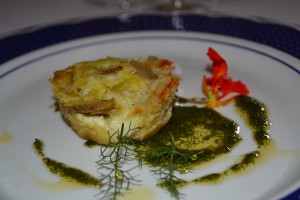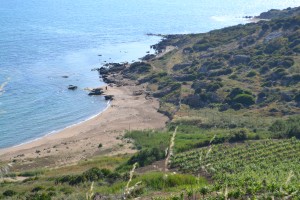 If Sicilian wines are still being incorrectly identified as emphasizing quantity over quality, another anachronism is that production by cooperatives automatically means poorly made wines. But, with MandraRossa’s intensive adaptation of technology and careful attention to every last detail, it’s clear that striving for quality isn’t restricted to family-owned wineries.
If Sicilian wines are still being incorrectly identified as emphasizing quantity over quality, another anachronism is that production by cooperatives automatically means poorly made wines. But, with MandraRossa’s intensive adaptation of technology and careful attention to every last detail, it’s clear that striving for quality isn’t restricted to family-owned wineries.
When I arrived at MadraRossa’s Casa Natoli, it was bustling with activity and after the relative quiet of being on my own since Monday morning, I was a bit flustered. But, after introductions were made by MandraRossa’s Brand Ambassador, Maria Isolina Catanese, I soon discovered how much I had actually been craving a full conversation in English. And, as my fellow guests were a group of restaurant managers from London, it wasn’t just English, it was English-English.
Built in 1830, Casa Natoli features the architecture of a typical country house and serves as home to MandraRossa’s cooking school. Ensconced in the Slow Food movement, the Kitchen Brigade at Casa Natoli prepared a multi-course meal featuring not just one, but several dishes comprising different varieties of artichokes (there’s more than one type of artichoke, who knew?), an especially bold move given that artichokes are often considered to be among the most challenging to pair with wine. Fortunately, the Fiano poured with lunch was indeed an excellent match.
After lunch, I was treated to a more formal presentation of the MandraRossa wines with a tasting out in the garden with the winemaker. The wines were quite lovely and the setting was simply heavenly. Then, the agronomist showed me their territory and provided additional details about their operations. Suddenly, we were back to speaking Italian, with the occasional translation from his more English-savvy colleague, when my requests for slower speech or repeated sentences proved insufficient to follow his meaning.
 Named for the local district, MandraRossa was founded in 1958 and is part of Cantine Settesoli, which manages the largest single vineyard area in the whole of Europe. However, only the top 10% of Settesoli’s production goes into MandraRossa wines. Today, the cooperative has 88 members, who farm a total of 7,000 hectares. Among the most planted varieties are Chardonnay and Syrah, followed by Nero d’Avola.
Named for the local district, MandraRossa was founded in 1958 and is part of Cantine Settesoli, which manages the largest single vineyard area in the whole of Europe. However, only the top 10% of Settesoli’s production goes into MandraRossa wines. Today, the cooperative has 88 members, who farm a total of 7,000 hectares. Among the most planted varieties are Chardonnay and Syrah, followed by Nero d’Avola.
The agronomist was keen to let me know how important it was to understand one’s terroir, explaining that they have spent significant time and effort to determine which varieties grows best where and then planting accordingly. In a further focus on quality, growers are advised by the agronomist when to harvest their vines and with which parameters to select their grapes. Moreover, harvesters are monitored by GPS, keeping careful tabs on what is going on within the region. Upon arrival at the winery (the cooperative maintains three), grapes are classified as A, B or C, depending on the quality of the crop, which consequently impacts the price paid to the grower.
Once the tour was over and I checked into the hotel, it was time for dinner. The Brits and I all climbed into a van and were taken to a seaside restaurant where we kicked off the evening with an aperitif on the beach, just as the sun began to set. We were joined by a local dog (who likely belonged to the restaurant) and I somehow managed to step (barefoot) on a bumblebee (yes, ouch!), but the view was too stunning to worry about the pain for long.
Dinner itself was an exquisite array of fresh seafood, including raw gamberi (shrimp) that were so sweet, it was like eating candy. The Brits were a rowdy bunch to put it mildly, freely admitting to having been literally under the table the night before at Planeta’s La Foresteria. Thankfully, they were more subdued that night (perhaps too tired out from the night before?), although one woman proceeded to regale us with stories of her battle with Nutella addiction (she was joking, at least I hoped she was joking). And, when sorbet was served at the end of the meal, they were all anxious to convert them to sgroppinos (a slushy cocktail). The waiter was only too happy to oblige, bringing the entire bottle of vodka to the table and letting us pour at will. I declined the first round, but gave in on the second (if you can’t beat ‘em…and all that).
